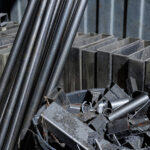
The Steel Industry in 2024: 10 Things To Remember
The steel industry, a cornerstone of modern manufacturing and construction, continues to evolve in 2024. Facing challenges and opportunities alike, it remains a dynamic and

The metal industry, a cornerstone of global manufacturing and construction, is undergoing a significant transformation. Driven by technological advancements and a growing emphasis on sustainability, the future of metal production and usage is evolving rapidly.
The metal production industry, a vital component of the global economy, is experiencing a renaissance of innovation and technological advancement. This transformation is reshaping how metals are produced, processed, and utilized, leading to groundbreaking changes in efficiency, cost-effectiveness, and environmental sustainability.
The field of metallurgy has seen significant advancements in recent years. New techniques in the processing and treatment of metals have resulted in materials with enhanced properties such as increased strength, improved corrosion resistance, and better thermal conductivity. These advancements are not limited to the properties of the metals themselves but also extend to the processes used in their production.
For instance, developments in smelting and refining technologies have made it possible to produce purer metal grades more efficiently. Innovations in casting and molding techniques have also allowed for more complex and precise metal shapes, broadening the range of applications for metal products.
One of the most transformative aspects of digital integration is the ability to monitor and optimize metal production processes in real-time. Manufacturers can now track the performance of their equipment and the quality of their products as they are being produced. This real-time monitoring allows for immediate adjustments to be made, ensuring optimal performance and reducing the likelihood of defects or downtime.
Real-time data analysis also supports predictive maintenance, where potential equipment failures are identified before they occur, significantly reducing unplanned downtime and maintenance costs.
The advancements in metal production represent a convergence of traditional metallurgical techniques with modern digital technologies. This fusion not only enhances existing production methods but also opens up new possibilities for the development and application of metal products. As the industry continues to embrace these changes, it stands on the cusp of a new era of efficiency, sustainability, and innovation.
The metal industry is at a pivotal juncture, with sustainability now at the forefront of its evolution. This shift towards green manufacturing practices is driven by a growing awareness of environmental impacts and a rising demand for eco-friendly products. Sustainable metal production is characterized by efforts to minimize environmental footprints, embrace renewable energy, reduce emissions, and promote recycling.
One of the key aspects of sustainable metal production is the integration of renewable energy sources. Solar, wind, and hydroelectric power are increasingly being used to power operations in the metal industry. This shift not only reduces the reliance on fossil fuels but also significantly cuts down carbon emissions associated with metal production. Companies are investing in solar panels, wind turbines, and other renewable energy infrastructure to power their facilities, making a clear statement of their commitment to sustainability.
Reducing emissions is another critical component of sustainable metal production. This involves not only cutting down on direct emissions from production processes but also addressing indirect emissions through the supply chain. Advanced technologies are being employed to capture and reduce emissions, such as carbon capture and storage (CCS) technologies. Additionally, process improvements and energy-efficient technologies are being implemented to reduce the overall energy consumption and environmental impact of metal production.
Recycling is a cornerstone of sustainable metal production. It serves multiple purposes:
The move towards sustainable metal production is not solely driven by environmental concerns; it is also a strategic business decision. Consumers and businesses are increasingly seeking out eco-friendly products and services, recognizing their role in promoting a sustainable future. Companies that adopt sustainable practices are likely to see enhanced brand reputation, increased customer loyalty, and potentially, access to new markets and customer segments.
While the shift towards sustainability presents numerous opportunities, it also comes with challenges. The initial cost of transitioning to renewable energy sources and implementing advanced emission reduction technologies can be high. However, these investments are often offset by long-term savings in energy costs, improved efficiency, and the potential for government incentives.
The era of sustainable metal production marks a significant transformation in the industry. By embracing renewable energy, reducing emissions, prioritizing recycling, and aligning with consumer preferences for sustainability, the metal industry is not only addressing its environmental impact but also positioning itself for long-term success in a rapidly evolving global market.
The realm of metal alloys is experiencing a surge of innovation, leading to the development of materials with exceptional properties tailored to specific industrial needs. These advancements are not just enhancing the performance and efficiency of traditional sectors but are also paving the way for new applications in various cutting-edge fields.
In the aerospace and automotive industries, the demand for materials that combine lightness with strength is paramount. Advanced alloys, particularly those based on aluminum, titanium, and magnesium, are being developed to meet these requirements. These materials contribute significantly to fuel efficiency, as lighter vehicles and aircraft require less energy to operate. Moreover, these alloys exhibit high resistance to environmental factors like temperature fluctuations and corrosion, which is crucial for the longevity and safety of aerospace and automotive components.
The renewable energy sector, particularly solar and wind power, is benefiting greatly from the development of new metal alloys. For solar energy, alloys that can withstand high temperatures and resist corrosion are crucial for the frames and supports of solar panels. In wind energy, strong and lightweight alloys are used in the construction of turbine blades and towers, enabling them to withstand harsh weather conditions and reduce the overall cost of energy production.
In the electronics industry, metal alloys play a critical role in the development of smaller, more efficient, and more durable devices. Alloys with high electrical conductivity and corrosion resistance are essential for connectors and circuit boards. Innovations in this area include alloys that maintain performance while being subjected to miniaturization, a common trend in electronic devices.
The medical device industry is another area where advanced metal alloys are making a significant impact. Alloys used in this sector need to be biocompatible, meaning they must not cause any adverse reaction when in contact with the human body. Titanium and its alloys are widely used for implants and surgical instruments due to their strength, lightweight, and corrosion resistance. Additionally, certain alloys are developed to be MRI-compatible, which is crucial for patients requiring regular imaging.
While the development of new metal alloys opens up numerous possibilities, it also presents challenges. The cost of developing and producing these advanced materials can be high, potentially limiting their accessibility and application. Furthermore, as the demand for these specialized alloys grows, there is a need for sustainable production methods to ensure that their environmental impact is minimized.
As the metal industry continues to evolve, it faces both challenges and opportunities. One of the major challenges is adapting to the rapid pace of technological change and the need for continuous innovation. Companies must invest in research and development, as well as in upskilling their workforce to stay competitive.
On the other hand, the industry has immense opportunities, especially in developing sustainable solutions and exploring new applications for advanced metal alloys. The growing demand for eco-friendly and high-performance materials across various sectors presents a significant market opportunity for those who can innovate and adapt.
Digital transformation is reshaping the metal industry at an unprecedented pace. The integration of AI, machine learning, and robotics in metal production is not only optimizing processes but also paving the way for smart factories. These smart factories are capable of self-regulation, predictive maintenance, and autonomous decision-making, leading to higher productivity and reduced downtime.
Government policies and regulations play a significant role in shaping the future of the metal industry. Policies promoting sustainable practices, recycling, and innovation can accelerate the adoption of green technologies and sustainable methods. Additionally, international trade policies and tariffs can significantly impact the global metal market, influencing supply chains and pricing.
The future of metal is marked by exciting trends and innovations. From sustainable production practices to breakthroughs in metal alloys and the integration of AI and automation, the industry is set for a transformative journey. As it navigates these changes, the metal industry not only contributes to global economic growth but also plays a crucial role in building a sustainable future. The key to success lies in embracing change, investing in innovation, and committing to sustainability, ensuring the metal industry remains a vital and dynamic part of the global economy.

The steel industry, a cornerstone of modern manufacturing and construction, continues to evolve in 2024. Facing challenges and opportunities alike, it remains a dynamic and

The construction industry has witnessed a significant transformation over the years, with the advent of new materials and technologies. Among these, Advanced High-Strength Steel (AHSS)

Understanding Metal Recycling Metal recycling is a process that breathes new life into used metals, transforming them into valuable resources once again. This process involves

The world of metals is as diverse as it is essential, playing a pivotal role in various industries and everyday life. Understanding the different types

In the metal manufacturing and processing industry, safety is paramount. The handling of different types of metals, each with its unique properties and potential hazards,

Pride Metals is a woman-owned steel service center that provides carbon, alloy, and stainless bar to machine shops, OEM’s, and manufacturers across North America.
COOKIE POLICY
PRIVACY POLICY
2022 PRIDE METALS. ALL RIGHTS RESERVED | POWERED BY STARFISH AD AGE